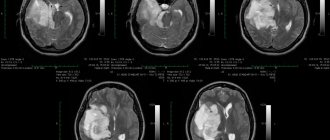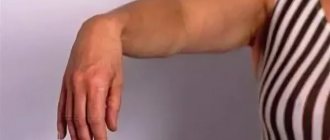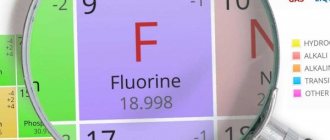What is PPCNS?
The very phrase perinatal period suggests that perinatal damage to the central nervous system develops in an unborn or newly born child. Perinatal damage to the central nervous system (PPCNS) is not one, but several diagnoses that imply dysfunction in the brain of a newborn child and can lead to persistent neurological consequences at an older age (for example, cerebral palsy, cerebral palsy).
The entire perinatal period is divided into three stages:
– from the 28th week until the moment of birth, the antenatal period ;
– the process of childbirth itself is called the intrapartum period ;
– the neonatal period is the period of time from the moment of birth to the 7th day of life inclusive.
In modern medicine there is no exact name for the disease when the central nervous system of the fetus is affected, there is only a collective one, it is called PPCNS or perinatal encephalopathy . Perinatal damage to the central nervous system in newborns is manifested by disturbances in the functioning of the musculoskeletal system, speech and mental disorders.
With the development of medicine, this diagnosis has ceased to be used for children older than one month. After a month, the doctor must make an accurate diagnosis of the child. It is during this period that the neurologist accurately determines how badly the nervous system is damaged. Prescribes treatment and ensures that it is chosen correctly.
What are the causes and risk factors for PPCNSL?
The reasons why perinatal damage to the central nervous system may develop are quite varied, among the most popular:
– somatic disease of the mother, which is accompanied by chronic intoxication;
– the presence of acute infectious diseases or chronic foci of infection while the expectant mother was carrying the child;
– if a woman’s nutritional process is disrupted, or she is not ripe for pregnancy and childbirth;
– disruption of uteroplacental blood flow during pregnancy;
– changes in metabolism also entail a disorder of the nervous system in the unborn child (increased bilirubin levels, neonatal jaundice);
– in case of severe toxicosis, both at an early stage and at a late stage, or the appearance of other problems with bearing a child;
– the environment is an important factor in the development of the disease;
– the appearance of pathology during childbirth - this may be weak labor, accelerated labor;
– if a child is born prematurely, then his body is not fully developed, therefore, against this background, a disturbance in the functioning of the central nervous system may appear;
– Children who have a hereditary factor are at greatest risk of developing central nervous system lesions.
All other causes of PPCNS are situational and, to a greater extent, their occurrence is simply impossible to predict. There are several ways of development of perinatal damage to the central nervous system in newborns, depending on the cause and subsequent symptoms, the analysis of which allows us to make an initial diagnosis:
– If a lack of oxygen is clearly detected while the baby is inside the mother’s body (hypoxia), then hypoxic damage to the central nervous system is diagnosed.
– During childbirth, the baby’s tissue structure may be damaged (this can be either the brain or the spinal cord). In this case, we are already talking about a traumatic lesion of the central nervous system, resulting in changes in the functioning of the brain.
– In case of metabolic disorders, metabolic and toxic-metabolic lesions may appear. This may be due to the use of alcohol, medications, or nicotine during pregnancy.
– Changes in the central nervous system in the presence of infectious diseases of the perinatal period.
Diagnostics:
It is necessary to conduct an ultrasound examination of the fetus, use cardiotocography (recording of the fetal cardiac activity) and Dopplerometry (study of the blood flow of the vessels of the uterus and umbilical cord of the fetus) with the frequency prescribed by the attending physician. Auscultation (listening) of the fetal heartbeat with a stethoscope is also used. It should be noted that not every pregnancy occurs against the background of the above diseases, complicating intrauterine fetal hypoxia. To prevent the possible occurrence of hypoxia, special attention is paid to its prevention: long walks in the fresh air, mandatory dosed physical activity (gymnastics, exercises, exercises for pregnant women and breathing exercises, swimming, yoga). It is possible to use hyperbaric oxygen therapy (HBO) as prescribed by the attending physician. It must be remembered that treatment must be prescribed by a gynecologist, be comprehensive and take into account an individual approach to each expectant mother.
What are the types of PPCNS syndromes?
PPCNSL is conventionally divided into several periods, depending on at what stage the disorder was identified and how it manifested itself.
– The acute period lasts from 7 to 10 days, it is extremely rare, but it can last up to a month.
– The period during which recovery occurs (recovery period) can last up to 6 months. If the child’s body recovers slowly, this period may take up to 2 years.
Pediatric neurologists distinguish the following types of perinatal lesions of the central nervous system, depending on the accompanying symptoms and syndrome:
– Violation of muscle tone . This syndrome is diagnosed according to deviations from the norm depending on the age of the infant. In the initial period of a child’s life, it is quite difficult to diagnose this syndrome, since in addition there is physiological hypertonicity (physiological stiffness of the newborn’s muscles).
– Nervous-reflex excitability syndrome is a syndrome associated with sleep disturbances, trembling of the chin, and the child flinching at any rustle or touch. This syndrome can be diagnosed only when somatic diseases of the newborn (for example, intestinal colic) are excluded. When examining such a child, the neurologist determines an increase in tendon reflexes, as well as an increase (revitalization) of the newborn’s automatisms (Moro reflex).
– Nervous system depression syndrome . This syndrome is the opposite in its characteristics to the previous one. It is diagnosed in children who are not active in the first months of their lives, they sleep a lot, they have decreased tone, they cannot hold their head up, and they have difficulty grasping their hands.
– An unfavorable prognosis for the child if intracranial hypertension syndrome . Its main signs are increased excitability and nervousness, while the fontanel begins to swell and thicken. Frequent regurgitation appears. Upon examination, the neurologist notices excessive growth of head circumference, possible divergence of the sutures of the skull, Graefe’s symptom (the “setting sun” symptom).
– One of the most dangerous and severe conditions in PPCNS is convulsive syndrome , which is one of the most serious manifestations of perinatal damage to the central nervous system.
In addition, any attentive mother can notice deviations in her child’s health much faster than a neurologist, if only because she monitors him around the clock and more than one day.
In any case, a baby living for the first year with any (even minimal, but not passing) deviations in health requires repeated consultations with specialists at the medical center, inclusion in the medical examination program (i.e. close observation by a neurologist and, if necessary, additional examination , such as ultrasound of the brain, electroencephalography, blood testing to determine the compensatory potential of the nervous system, etc.). Based on the findings received, the center’s specialists develop a development plan for such a child, select an individual scheme for preventive vaccinations, introduce complementary foods into the diet, and carry out therapeutic measures if necessary.
What are the symptoms and diagnostic criteria for PCNSL?
– Not every mother who does not have a medical education will be able to distinguish and determine at first glance that her child has a perinatal lesion of the central nervous system. But neurologists accurately determine the disease by the appearance of symptoms that are not characteristic of other disorders.
– when examining the baby, muscle hypertonicity or hypotonicity may be detected;
– the child is excessively restless, anxious and excited;
– the occurrence of trembling in the chin and limbs (tremor);
– the appearance of seizures;
– when examined with a hammer, a violation of the reflex sphere is noticeable;
– the appearance of unstable stools;
– heart rate changes; the appearance of irregularities on the child’s skin.
As a rule, after a year these symptoms disappear, but then appear with renewed vigor, so this situation simply cannot be neglected. One of the most dangerous manifestations and consequences of PPCNSL in the absence of a response to symptoms is the suspension of the development of the child’s psyche. The speech apparatus does not develop, and there is a delay in the development of motor skills . Also, one of the manifestations of the disease may be cerebrasthenic syndrome.
Osteopathic examination
An examination by an osteopathic doctor involves not only a neurological examination, but also a search for anatomical abnormalities in the structure of the skull, cervical vertebrae, sacrum, ribs, etc. All this is of great importance for the child’s health, since the slightest deviations in anatomy are projected on an enlarged scale into the future life of the baby. Osteopathic diagnosis is carried out by a doctor and includes:
- Examination: determination of the arch of the body, position of the limbs, behavior of the child.
- Assessing the amplitude, strength and rhythm of the primary respiratory mechanism.
- Assessment of the pattern of the craniosacral system.
- Testing the mobility of the cervical and lumbosacral spine.
- Global skull test, assessing the mobility of each of the bones of the arch and base.
- Diagnosis of intraosseous injuries of the skull and sacrum.
After the examination, the osteopathic doctor gets an idea of all the anatomical disorders in the child’s body and immediately begins treatment.
How is PCNSL treated?
To restore the basic functions of the central nervous system, as well as to reduce the manifestation of neurological symptoms, the baby is prescribed a whole range of medications. Treatment can include, for example, nootropic drugs that can restore trophic processes in the brain - piracetam, Cerebrolysin, Cortexin, pantocalcin, solcoseryl and many others. In order to stimulate general reactivity, a newborn child is given a course of therapeutic massage, special gymnastics, and, if necessary, a set of physiotherapeutic procedures (for example, electrophoresis and microcurrents).
If parents detect at least one of the signs of central nervous system damage, they should immediately consult a doctor. Do not forget that the development of each child is an individual process. Such individual characteristics of a newborn child in each specific case play an important role in the process of restoring the functions of higher nervous activity.
Treatment of PPNS
Treatment of newborns in the acute period of PPNS is carried out in a hospital setting and is represented by the following measures: ensuring adequate oxygenation; artificial ventilation of the lungs (according to indications); dehydration; hemostatic therapy; anticonvulsant, metabolic and vascular therapy; antibacterial and immunotherapy. In the recovery period of PPNS, a wider range of nootropic, neurometabolic, neuropeptide, vascular and anticonvulsant drugs are used to treat clinical syndromes; if necessary, muscle relaxants and multivitamin complexes are used (group B). Among the methods of non-drug treatment of PPNS, the main role belongs to general massage and exercise therapy; according to indications, physiotherapy and acupuncture are used.
What are the dangers and consequences of PPCNS?
There is an opinion among experts that if the central nervous system of the fetus has been damaged, it cannot be completely restored. But practicing neurologists say the opposite. They say that if the disease is treated correctly and in a timely manner, it is possible to achieve partial or complete restoration of the functions of the nervous system. But even despite such an optimistic forecast, if you look at all possible diseases of a child associated with the nervous system, then 50% of their total number leads to disability, while about 80% of it is allocated to perinatal damage to the central nervous system.
Forecast
The child’s recovery is possible, and a full recovery occurs. However, it cannot be ruled out that the baby will remain disabled if the hypoxia was severe. It is also possible to develop minor brain dysfunction with an asymptomatic course of the pathology.
The consequences of hypoxic-ischemic encephalopathy are epilepsy, cerebral palsy, hydrocephalus, mental retardation. The latter disorder is persistent over time; mental retardation cannot be cured.
If a child is slightly delayed in development during the first year of life, but receives adequate treatment, most likely he will catch up with his peers in the near future, and will be no different from healthy children.
Author of the article:
Alekseeva Maria Yurievna |
Therapist Education: From 2010 to 2021 practicing physician at the therapeutic hospital of the central medical unit No. 21, the city of Elektrostal. Since 2021 he has been working at diagnostic center No. 3. Our authors








